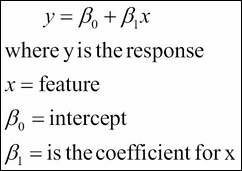Linear regression
The main goal of using linear regression is to predict a numeric target value. One way to do this is to write an equation for the target value with respect to the inputs. For example, assume that we are trying to forecast the acceptance rate of a fully rounded student who participates in sports and music, but belongs to a low-income family.
One possible equation is acceptance = 0.0015*income + 0.49*(participation_score); this is a regression equation. This uses a simple linear regression to predict a quantitative response with a single feature. It takes the following form:

Together, β0 and β1 are called the model coefficients. To create our model, you must learn the values of these coefficients. Once you've learned these coefficients, you can use the model to predict the acceptance rate reasonably.
These coefficients are estimated using the least squares criteria, which means that we will find the separating line mathematically and minimize the sum of squared residuals. The...



























































